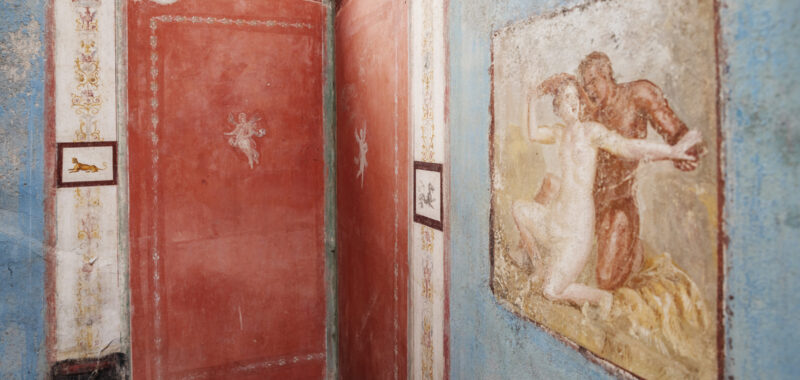Archaeologists at Pompeii have unearthed a small home featuring at least four frescoes in the Insula dei casti Amanti or House of Chaste Lovers complex, the park announced last week.
Contradicting the name of the site at which the works were discovered, these Fourth Style frescoes, associated with the period between 62–79 CE, aren’t exactly chaste. Perhaps unsurprisingly given the explicit content of much previously excavated art at the ash-preserved Ancient Roman city, the works on the walls of the house are both erotic and mythic in nature. For its size, the park said in a statement, the small house contains a “high level of wall decorations,” some of which are sexually graphic.
The small house was discovered as part of an ongoing excavation of the northeast section of the complex, named after a painting of a subtle kiss between a man and a woman.
While some of the frescoes found in the dwelling were damaged during early 19th-century excavations, the archaeological park said, one of the paintings was particularly well preserved and inspired its provisional name: House of Phaedra. It depicts Euripides’s tragedy based on the Greek myth of Hippolytus, in which the Cretan princess Phaedra falls in love with the divinity, who rejects her, leading Phaedra to kill herself and leave a note accusing the god of raping her. As the story goes, Hippolytus’s father, the King of Athens Theseus, invokes Poseidon to punish his son.
In the House of Phaedra fresco, the princess is pictured partially nude and sitting in a chair, head bowed, while a bronze-colored and nude Hippolytus (whose large phallus is partially covered by cracks in the surface) projects a wide-eyed stare at Phaedra. An older man, possibly meant to be Theseus, grabs his arm.

The most graphic work in the recent round of discoveries is an artistic depiction of copulation between a satyr, the hypersexual and wine-loving mythological creature, and a nymph. Obscured by damage from an earlier excavation, another fresco shows a man and a woman believed to represent Venus and Adonis. A fourth damaged fresco may portray the Judgement of Paris, a mythical contest between the most beautiful Greek goddesses.
Relying heavily on Greek mythology, the paintings encapsulate a Roman Empire not dominated by Christianity, frozen in time by the eruption of Vesuvius in 79 CE, about two centuries before Christianity became the empire’s official religion.
Architecturally, the home is notable in that it does not contain an atrium with a basin to collect rainwater, as was typical of Pompeian houses. In a recent academic journal article, Pompeii archaeologists linked the absence of atriums after six centuries of popularity to societal changes in the years leading up to the volcano’s eruption.

Aside from the frescoes, the House of Phaedra was also found to contain an altar decorated with a painted flying bird of prey towering above two snakes. According to Pompeii’s archaeologists, the altar once held a last offering which included burned essences, a fig lead, and a red marble figure of a deity.
Archeological Park of Pompeii Director Gabriel Zuchtriegel said in a statement that the excavation is “an example of public archaeology,” referencing the fact that the house was uncovered and restored “under the eyes of visitors” at a site viewable to the public.

